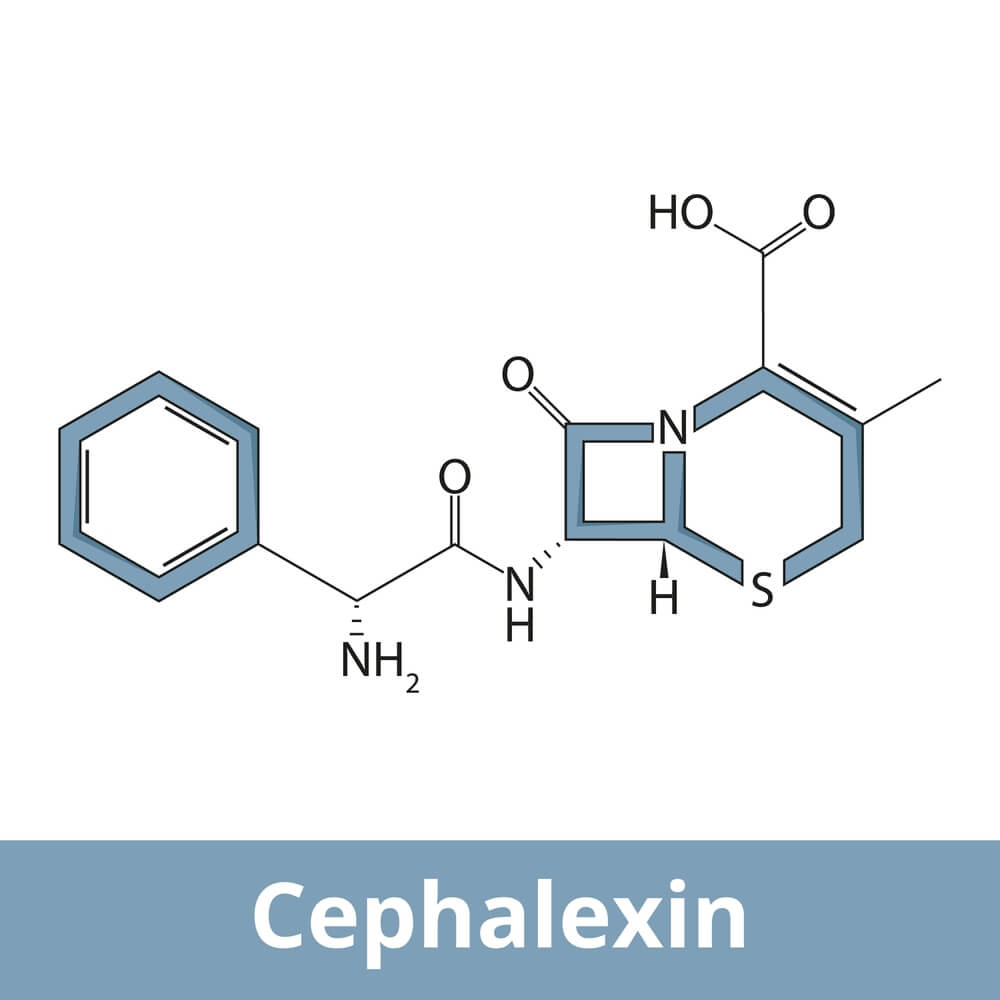
Cephalexin, a broad-spectrum cephalosporin antibiotic, treats bacterial infections in dogs, including skin, urinary tract, respiratory, and bone infections by disrupting bacterial cell walls. Understanding dosage guidelines and potential side effects is crucial for pet owners. This guide covers Cephalexin’s usage, dosage recommendations, side effects, and alternatives for canine infections.
What is Cephalexin and Why is it Prescribed for Dogs?
Cephalexin is a broad-spectrum antibiotic commonly prescribed in veterinary medicine to treat bacterial infections in dogs. As a member of the cephalosporin class, it works by interfering with the formation of the bacteria’s cell wall, ultimately leading to the destruction of the bacterial cells. Cephalexin for dogs usage includes treating skin infections, urinary tract infections, respiratory infections, and bone infections.
Veterinarians often choose cephalexin antibiotic for pets due to its effectiveness against a wide range of bacteria and its relatively low risk of side effects. It is particularly useful for managing skin conditions such as pyoderma and abscesses caused by Staphylococcus species. Additionally, cephalexin is well-tolerated by most dogs and can be administered orally in tablet or liquid form.
Understanding why cephalexin is used in veterinary medicine involves recognizing its role in combating bacterial resistance and ensuring pet health. By prescribing this antibiotic, veterinarians aim to eliminate harmful bacteria while minimizing adverse reactions, making it a trusted option for treating various bacterial infections in dogs.
How Cephalexin Works to Treat Bacterial Infections in Dogs

Cephalexin is a widely prescribed antibiotic for treating bacterial infections in dogs. It belongs to the class of cephalosporins, which are known for their broad-spectrum antibacterial activity. The cephalexin mechanism of action involves inhibiting the synthesis of the bacterial cell wall. By binding to specific penicillin-binding proteins inside the bacteria, cephalexin disrupts the formation of peptidoglycan, an essential component of the bacterial cell wall. This disruption weakens and eventually causes the bacteria to die, effectively eliminating the infection.
Bacterial infections in dogs can manifest in various forms, including skin infections, urinary tract infections, respiratory infections, and bone infections. Cephalexin is effective against a wide range of Gram-positive and some Gram-negative bacteria that commonly cause these conditions.
When it comes to antibiotics for canines, it’s crucial to follow veterinary guidance on dosage and duration to ensure optimal results and prevent antibiotic resistance. Typically administered orally in tablet or liquid form, cephalexin should be given with food to minimize gastrointestinal upset.
Cephalexin plays a vital role in treating bacterial infections in dogs by targeting and destroying harmful bacteria through its unique mechanism of action. This makes it an invaluable tool in veterinary medicine for ensuring our canine companions remain healthy and free from infection.
Proper Dosage of Cephalexin for Dogs
Understanding the correct dosage of cephalexin for dogs is crucial to ensure effective treatment and avoid potential side effects. Cephalexin, a broad-spectrum antibiotic, is commonly prescribed to treat bacterial infections in dogs. Here’s a detailed look at the proper dosage guidelines and recommendations.
When determining how much cephalexin to give a dog, it’s essential to consult with your veterinarian. The dosage can vary based on the dog’s weight, age, and the severity of the infection. Generally, the standard cephalexin dosage for dogs ranges from 10 to 15 mg per pound (22 to 30 mg/kg) of body weight, administered every 8 to 12 hours.
To make it easier for pet owners, many veterinarians provide a cephalexin dosage for dogs chart. This chart typically outlines specific dosages based on various weight categories. For instance:
– A dog weighing up to 10 pounds may require approximately 100-150 mg.
– A dog weighing between 10-25 pounds may need around 250 mg.
– Dogs weighing between 25-50 pounds might be prescribed about 500 mg.
– Larger breeds weighing over 50 pounds could require doses ranging from 750 mg or more.
It’s important to follow pet medication dosage guidelines strictly and complete the full course as prescribed by your vet, even if your dog shows signs of improvement before finishing the medication. Abruptly stopping an antibiotic can lead to incomplete eradication of bacteria and potentially contribute to antibiotic resistance.
Always monitor your pet for any adverse reactions while they are on cephalexin. Common side effects might include gastrointestinal issues such as vomiting or diarrhea. If you notice any severe reactions or if symptoms persist beyond a few days without improvement, contact your veterinarian immediately.
Administering the correct dose of cephalexin is key in treating bacterial infections effectively in dogs. Always adhere closely to veterinary advice and use provided charts or guidelines as references when managing your pet’s medication regimen.
The Potential Side Effects of Cephalexin in Dogs You Should Be Aware Of
When it comes to treating bacterial infections in dogs, cephalexin is a commonly prescribed antibiotic. However, as with any medication, it’s essential to be aware of the potential side effects of cephalexin in dogs to ensure your pet’s well-being.
One of the most frequently observed adverse reactions to antibiotics in pets, including cephalexin, is gastrointestinal upset. This can manifest as vomiting or diarrhea and may cause discomfort for your dog. Monitoring their eating habits and bowel movements while on the medication is crucial.
Another common side effect of pet medications like cephalexin is an allergic reaction. Signs of an allergic reaction can include itching, swelling, hives, or difficulty breathing. If you notice any of these symptoms, it’s important to contact your veterinarian immediately.
Some dogs might also experience lethargy or a decrease in appetite while taking cephalexin. Although less common, these symptoms should still be monitored closely and reported to your vet if they persist.
In rare cases, more severe side effects such as changes in behavior or neurological issues can occur. While these instances are infrequent, being vigilant about any changes in your dog’s health during their course of treatment with cephalexin is vital.
Understanding the potential side effects helps ensure that you can act quickly if any adverse reactions occur. Always consult with your veterinarian before starting any new medication for your pet and follow their guidance closely throughout the treatment process.
Precautions and Considerations When Administering Cephalexin to Your Dog
Administering Cephalexin to your dog requires careful consideration and adherence to veterinary guidelines to ensure the safety and effectiveness of the treatment. Cephalexin, a cephalosporin antibiotic, is commonly prescribed for bacterial infections in pets, but there are several precautions and considerations to keep in mind.
First and foremost, always follow your veterinarian’s dosage instructions precisely. Overdosing or underdosing can lead to ineffective treatment or potential side effects. It’s crucial never to administer Cephalexin that was prescribed for another pet or human, as the dosage requirements can differ significantly.
Monitoring your dog for any adverse reactions is another critical aspect of safe administration. Common side effects may include gastrointestinal upset such as vomiting or diarrhea. If you observe any severe reactions like difficulty breathing, swelling, or hives, contact your veterinarian immediately.
Additionally, inform your vet about any other medications or supplements your dog is currently taking. Drug interactions can pose significant risks and may require adjustments in therapy. This is particularly important if your dog has pre-existing health conditions that could be exacerbated by antibiotics.
Lastly, complete the full course of antibiotics as prescribed even if your dog’s symptoms improve before finishing the medication. Stopping treatment early can lead to antibiotic resistance and recurrence of infection.
By adhering to these safety tips for giving dogs Cephalexin and following veterinary advice on cephalosporins use in pets, you can help ensure a safe and effective recovery process for your furry friend.
Alternatives to Cephalexin (Other Antibiotic Options for Canine Infections)
When it comes to treating canine infections, Cephalexin is a commonly prescribed antibiotic. However, there are several alternative antibiotics for dogs’ infections that pet owners and veterinarians can consider. Understanding these options can help in making informed decisions about your dog’s health.
One notable alternative to Cephalexin is Amoxicillin-Clavulanate. This combination antibiotic is effective against a broad spectrum of bacteria and is often used for skin infections, respiratory issues, and urinary tract infections in dogs. Another option is Clindamycin, which is particularly useful for dental infections and bone-related issues due to its ability to penetrate bone tissue effectively.
For more severe or resistant infections, Enrofloxacin may be recommended. This potent antibiotic covers a wide range of bacterial pathogens and is often reserved for cases where other treatments have failed or when the infection poses significant health risks.
In addition to these alternatives, veterinarians may also prescribe Doxycycline for conditions such as Lyme disease or leptospirosis. Doxycycline has anti-inflammatory properties that make it suitable for treating certain tick-borne diseases along with its antibacterial effects.
It’s essential to consult with a veterinarian before opting for any alternative treatments besides Cephalexin. They can provide guidance on the most appropriate canine infection treatment options based on the specific type of infection and your dog’s overall health condition.
Ensuring the Safe and Effective Use of Cephalexin for Your Dog’s Health
Ensuring the safe and effective use of Cephalexin for your dog’s health requires a thorough understanding of the medication and its proper administration. Cephalexin, a commonly prescribed antibiotic for bacterial infections, can be highly beneficial when used correctly. It is crucial to follow your veterinarian’s dosage instructions precisely, as improper dosing can lead to ineffective treatment or potential side effects.
Monitoring your dog for any adverse reactions during the course of treatment is essential. Common side effects may include gastrointestinal upset, such as vomiting or diarrhea. If you observe any severe reactions or if symptoms persist, contact your veterinarian immediately.
Additionally, completing the full course of antibiotics is vital even if your dog appears to be feeling better before the medication is finished. Stopping treatment early can result in a resurgence of the infection and contribute to antibiotic resistance.
By adhering to these guidelines and maintaining open communication with your veterinarian, you can help ensure that Cephalexin effectively contributes to your dog’s health and recovery.



